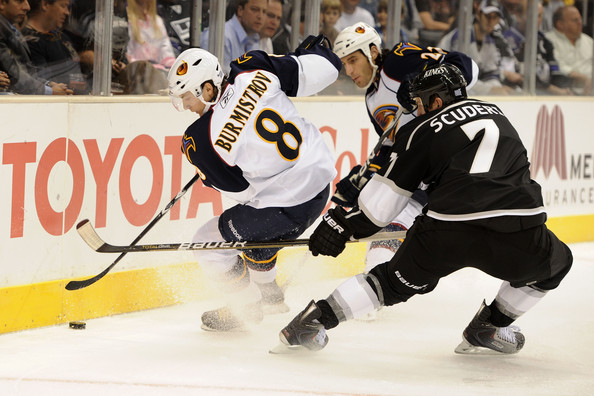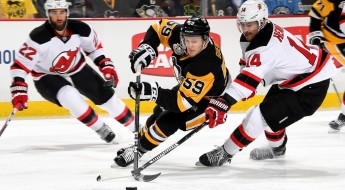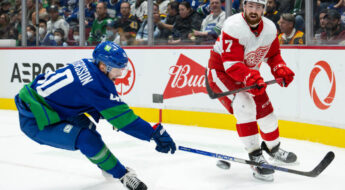What Exactly Do The Jets Have With Alexander Burmistrov?

Alex Burmistrov shields the puck from LA defenseman Rob Scuderi. Image courtesy of www.snipview.com.
First Dance in the Big League
Back in June of 2010 when then-Thrashers GM Rick Dudley selected Alex Burmistrov with the 8th overall pick, he conveyed his excitement almost from day one. Noted as a player “we had been targeting a long, long time”, Dudley was elated at the possibility of finally having a true number one playmaking center, a vacancy that had never been filled since losing Marc Savard to free agency four years earlier in 2006. Right after the draft Dudley evaluated Burmi as being a “brilliant two way player”, and during his rookie season in Atlanta he held the fort strongly as an 18 year old third line center, offering sound defensive play and a willingness to play in any role. Other than being a little undersized, he certainly didn’t look out of place. He’d finish his 18 year old season with 6 goals and 14 assists in 74 games,
Entering 2011, with all the hype of hockey’s return to Winnipeg, it was a memorable year for many reasons: the first Jets goal, the unveiling of the new uniforms, and the jam packed MTS Center rapidly climbing the ranks of the NHL’s loudest building. It was, however, not memorable for the second year center. Showing reasonable improvement on his first year (13g, 15a), Burmistrov also started displaying the signs of a player who started playing in the NHL just a little too early. So concerned about getting his defensive duties correct and being reliable, you started to see a little bit less of what made him such an intriguing prospect back in the OHL with the Barrie Colts. During his rookie season – before his offensive instincts were crushed out of him – you saw amazing tight turns in the offensive zone, firing off a pass mid turn to find a streaking winger. You saw him try to use his soft hands a little more to pull the puck quickly away from the defender and without missing a beat find a pass to his teammate. During his second year, we also saw him slowly start to hold the puck a little bit less along the boards than normal, after being outmuscled hundreds of times during his 75 game rookie season. It’s a shame, because his ability to control the puck along the boards in junior was one thing that allowed him to be so electric; combining that with his vision and hands, you saw the potential for a fascinating playmaking package.
Enter 2012, and it’s where things start go south for the young Russian. With the lockout, I remember being excited to see what he could do with a little softer competition in the AHL. Burmi played 22 games down in St. John’s, but only mustered up 2 goals and 11 assists, and erased any real excitement I had for his progression up in Winnipeg.
Once the season started that fateful January, the top line center spot was obviously going to Bryan Little. That left longtime veteran and four time 30 goal scorer Olli Jokinen and Mr. Burmistrov to battle it out for the 2nd and 3rd line duties. Throughout the season they largely switched roles in spurts, handling the second line spot for 3 or 4 games than passing it along, as they both weren’t particularly effective offensively all season. The biggest difference in their ice time though, was how it was distributed: Burmi was penalty killing over two minutes a game while receiving minimal power play time, and Jokinen was doing exactly the opposite, receiving over 2 power play minutes per game and doing minimal penalty killing. There’s a possibility that this is where Burmistrov’s perceived riff with head coach Claude Noel started, as Jokinen generated only 1 power play point all season, despite playing 65 more minutes on the power play than the then-20 year old Russian. The season ended with Burmistrov putting up 10 points and an even plus minus, with his Finnish counterpart putting up 14 and adding a team worst -19 to the equation. It is possibly justified that he should have been getting more opportunity than Jokinen, but Noel must have saw something that I (and everyone else) didn’t.
Heading to Russia
Being a restricted free agent in the summer of 2013, Burmi ended up jumping ship over to the KHL where he was hoping to earn more more playing time and an expanded role.
It’s hard to make out exactly what transpired over in Russia, as Burmi’s first year overseas went pretty well. He lead Ak-Barz Kazan in points with 37 in 54 GP (a 56 point pace over 82 games), while also winning over 53% of his draws. He was also in the top 3 for ice time among forwards, showing he had earned the trust of head coach Valeri Belov. What muddles up any real assessment is the regression during his second year in Russia. Burmistrov’s average ice time descended by a minute per game to 16:26/game, and his point totals dropped down to 26 in 53 games, just under a 41 point pace over an 82 game season.
It’s rumoured he never saw eye to eye with the new Kazan coach, Zinutela Bilyaletdinov. However, after having a perceived rift with former Jets coach Claude Noel and now one of his two Russian coaches, you can’t exactly say there’s a favorable pattern forming there.
Return to Canada
The x-factor for Burmistrov’s return to Canada may be Jets head coach Paul Maurice. Maurice connected with the young forward in 2014 during the IIHF World Championship, a critical factor in getting him back into the NHL. He did his due diligence in finding out exactly what led to Burmi’s departure, and it will ultimately come down to him to make sure Burmi is used effectively back in the big leagues. Maurice has been quoted frequently saying he has “lots of time for this young man as a player”, implying there is the role available that Burmi is craving in the NHL. Maurice is also known to be a fantastic communicator, something a young talented player like Burmistrov needs. A player with such an offensive skillset sometimes needs clarity for why they’re moving around in the lineup, and we know Maurice doesn’t shy away from line shuffling and player swapping.
Perhaps the most important factor for Burmi returning is he’s just a piece of the puzzle now. He doesn’t need to come in and try to be the offensive catalyst. The Jets have a team identity, they have team leaders, and they have now built a standard for what it means to wear a Winnipeg Jets uniform. A locker room that polices itself was one of Maurice’s intentions since day 1 and it’s clear that he has achieved that. If Burmistrov wants it his way or doesn’t agree with him, there’s such a team mentality there now that it simply just won’t matter. Maurice has a view for how the game should be played, and we know he’s not afraid to reduce roles of players who aren’t buying in.
I use Dustin Byfuglien as an example. Last year he started at forward because Maurice didn’t like the way he lazed around in his defensive zone. The only reason Byfuglien stayed at defense after filling in for injuries is because of Maurice’s won’t-take-no-for-an-answer attitude. Byfuglien knew he had to commit to playing sound defense first, or he would be back at forward. And lone behold, ‘Big Buff’ had his best season as a Jet – and most importantly – his best defensive season. Team culture effects like this go a long way towards developing young players like Burmistrov.
Burmistrov’s main assets are his unique skating ability (the tight turns I mentioned previously), his passing skills in combination with his vision, and his defensive acumen. He also does have a surprisingly effective wrist shot – but you’d like to see it used a little more often (1.55 SOG/game in his 5 pro seasons). Former Jet Michael Frolik has a similar skillset, and he was able to score back-to-back 42 point seasons, playing as a utility forward but also seeing plenty of time with top forwards Bryan Little and Andrew Ladd. Maurice seems to envision Burmistrov playing in the same spot, and he has far more offensive ability than Frolik, so it will be fascinating to see just what he ends up doing this year.
Best case scenario, I see Burmi in the 50-55 point range. If he gels with Ladd and Little, he certainly has the skill to put up points while still fulfilling the role that Maurice describes as “having to be better than the opponents’ top line”. Maurice has also noted he feels that Burmi has the capability of being able to “grow into that role”, suggesting there will be a long leash with which to work with.
If that line doesn’t work out, there’s still plenty of skill throughout the Jets top 9. If he ends up playing with say Mathieu Perreault and Adam Lowry, there’s still enough of a dynamic there for him to fight for the 40 point plateau.
Plenty of factors, plenty of possibilities. Only time will tell.




Leave a Comment